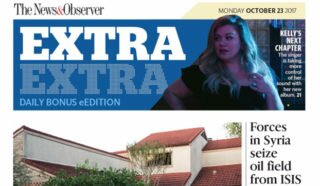
It’s not a good time to be a newspaper reader who enjoys getting that news via the print edition. Deadlines have moved so early that it can never be as timely as it was years ago, forcing readers to use digital sources to stay updated.
Why are deadlines so early?
One reason is to further shift emphasis to digital. The other is much the same reason that newspapers around the country are reducing staffs on a regular basis: With plenty of red ink on the ledgers of newspaper chains, they are always looking for ways to cut costs.
Knowing that print editions aren’t nearly as popular, management has looked for ways to produce them more cheaply. In doing so, it’s no doubt frustrating print-edition lovers and making print even less popular.
Not only are print-edition deadlines much earlier even a couple of years ago, the deadlines for The N&O and The Herald-Sun are the earliest of the 11 newspapers McClatchy News Desk East in Charlotte designs.
The deadline for the last page to be finished for the Centre Daily Times of State College, Pa., is 11:45 p.m. (11 p.m. for Sunday’s paper). At the Charlotte Observer, it’s 10 p.m. for the Monday through Friday papers, 11 p.m. for Saturday and 7:30 p.m. for Sunday. But the deadline is 7:45 p.m. (6:55 p.m. for Sunday’s paper) for Durham and 8 p.m. (7:30 p.m.) for Raleigh.
A 6:37 p.m. post time for Saturday’s Belmont Stakes was too late for a story to make The Herald-Sun, although a story appeared in at least some print editions of The N&O. News broke at 6:10 p.m. June 8 on Twitter that Cameron Johnson was cleared to play next season at UNC. Neither paper had a story in the next day’s print edition.
Drescher said that the deadlines for Durham and Raleigh have nothing to do with both being designed at the Charlotte hub. Rather, he says it’s related to printing and delivery, which have changed since the days not that long ago when Raleigh’s deadline was much later in the evening.
“It has to do with our press in Garner and when it needs to start,” Drescher said. “We have to run The Herald-Sun, to run The N&O, to hit the routes at the time we need to hit them. We have early deadlines now.”
The reason deadlines are so much earlier, he said, relate to how McClatchy is staffing its Garner press and the impact of having fewer carriers and longer routes.
“Every step of the way, we’re trying to get those costs down so we can devote more of our resources to digital,” he said. “We have a different press now than we used to have and there’s a way to run a press depending on how many operators you want running the press. The bigger theme here is that we have taken steps to lower our print-production costs — our legacy costs — so we can divert more money to digital.
“There’s a lot of complexity that has to do with the length of your routes and has to do with the capacity of your press and it has to do with how many guys and women you have to run your press and we’ve made the conscious decision to try to lower our print-production costs as much as possible,” he said.
Some of the savings has come by reorganizing the home delivery of the print editions of The N&O and The Herald-Sun.
“If you lengthen and consolidate routes, you can lower costs. But if you lengthen your routes it takes more time,” he said. “So, that’s just one part of the chain of what happens when the story leaves the newsroom to the time it goes to the press to the time it goes to the trucks to the time it goes to the carrier.”
Because The Herald-Sun is printed first and its press run is so short, it’s highly unlikely that pages would ever be replated (or updated) to include breaking news or updated stories. It has happened recently for The N&O: Late editions were updated to include UNC’s season-ending baseball loss to Davidson.
The Tar Heels’ two Final Four games, both of which were played late in the evening, made it in the print editions of both newspapers. The Final Four, of course, is a high bar, but Drescher says not to expect a lot of that in the future.
“I think that bar is going to get higher as time goes on,” he said. “I think, as time goes on, we’ll replate less and less as readers get more and more comfortable and familiar with going online.
“All the growth in readership and in ad revenue is on the digital side, so that’s where our focus is,” Drescher said. “The bottom line is to give later deadlines, or to do a lot of replates costs money. We’re really trying to get our readers to go for any kind of news, especially late news, to go to our digital products.”
Community newspapers phased out
The N&O’s community newspapers as they have existed for years have been discontinued. The nameplates remain but the news content is fairly similar for each newspaper and isn’t catered to the respective communities.
If the stories on the front page are about topics related the city or town name on the nameplate at the top of the front page — at least if the last week is an indication of the plan — it’s a coincidence.
Drescher explained the changes in this column.
Wednesday’s editions now focus on food with the same stories on the front pages of all 10 papers and have “the dish” under the nameplate. Sunday’s editions are a collection of stories from recent daily editions. All 10 had basically the same front page on Sunday and the similar interior content.
The feature story on the front page of all 10 editions Sunday was Josh Shaffer’s feature on runner Scott Waldrop, who has battled through alcoholism and will run the Leadville 100 in August. That story went on The N&O’s website June 1.
The last editions that truly were catered to the specific areas where the community newspapers are delivered was Sunday, June 4.
They still will be printed and delivered to some non-subscribers and appear in the e-edition. The Charlotte hub is now designing all pages again, and that’s fairly easy for the “community newspapers” since the content is the mostly the same.
There are no longer editor positions for the newspapers.
Mark Schultz, who was editor of the Chapel Hill News and The Durham News, will become managing editor of The Herald-Sun and lead the newsroom starting June 23. Scott Bolejack, who was editor of the Smithfield Herald, the Clayton News-Star, the Garner-Clayton Record and the Eastern Wake News, is now part of the N&O’s print team. Sarah Nagem, who was the editor for The Cary News, the North Raleigh News, the Southwest Wake News and the Midtown Raleigh News, continues as an assistant Metro editor.








